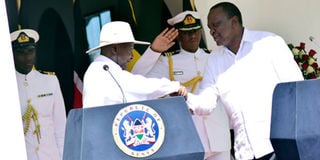Uhuru-Museveni talks signal hope for SRG plan, Migingo peace

Ugandan President Yoweri Museveni with Kenya's Uhuru Kenyatta after their joint press conference at State House in Mombasa on March 27, 2019. PHOTO | LABAN WALLOGA | NATION MEDIA GROUOP
What you need to know:
- China Exim Bank are the financiers of the railway project for both countries. However, no concrete deal has come out of this, leaving Uganda frustrated.
- Uganda is Kenya’s biggest market for its goods and the Port of Mombasa serves as its biggest client, especially for transit cargo, ahead of DR Congo, South Sudan and Rwanda.
As Ugandan President Yoweri Museveni takes his maiden ride on the Standard Gauge Railway from Mombasa to Nairobi on Thursday, at the back of his mind will be his country’s desire to get a written commitment from his Kenyan counterpart Uhuru Kenyatta on extending the railway line from Kisumu to the border town of Malaba.
The two countries have been having a back and forth over the financing of the last leg of Kenya’s SGR, with China Exim Bank insisting that Kampala has to get Kenya’s commitment to build its last phase before Uganda can secure funding for the Malaba to Kampala section.
“We have had great progress on these discussions; and it will be a great pleasure to be using this train. It will be a game changer, especially for movement of cargo from Mombasa to Kampala, cutting down the time to just one day,” President Museveni said during their joint briefing in Mombasa on Wednesday.
TRANSPORT
For Kampala, Kenya’s commitment to build the Kisumu-Malaba phase is very important as it will unlock multibillion-dollar funding for the line from Malaba to Uganda’s capital, Kampala.
In the past seven months, the two countries have hosted Chinese delegations led by China Vice premier Wang Yang, and China Exim Bank chairperson Li Ruogo.
China Exim Bank are the financiers of the railway project for both countries. However, no concrete deal has come out of this, leaving Uganda frustrated.
“The SGR train has evidently improved transport of cargo from Mombasa to Nairobi; and I am now keen on the joint development of the SGR line to Kampala in Uganda,” Mr Kenyatta said.
“We have seen the great progress made by Kenya in enhancing movement of cargo. There are now less blocks along the Northern Corridor; and we also have seen investments in the pipeline and jetty, which will make it easy for goods to reach us in Uganda,” President Museveni said.
PORT EFFICIENCY
He added: “I am also happy with progress of the talks on the projects, which will benefit the two countries. Before Uhuru’s time some people at the port thought that they were doing Uganda some favour by clearing their cargo, not knowing that they were sabotaging the economies of the two countries, but now we are celebrating the intervention by President Kenyatta.
"With the reinforcement support for hinterland economy and Kenya’s, we are looking forward to the extension of the SGR line, which I know when it is completed it will take 24 hours to Kampala.”
The Ugandan Head of State is also expected to tour the Mombasa Port, which handles more than 80 per cent of Kampala’s imports, and is an important player in the country’s economy.
“I am happy that we are now seeing very good levels of efficiency in this port. It is very key to us, and having the joint revenue authorities sitting here under the East African Customs negotiations, shows that we can achieve much through collaborations and cooperation,” President Museveni said, adding that the turnaround time for transit goods to Kampala had been reduced from 19 days to four days.
Uganda is Kenya’s biggest market for its goods and the Port of Mombasa serves as its biggest client, especially for transit cargo, ahead of DR Congo, South Sudan and Rwanda.
TRADE
According to the Kenya Ports Authority 2017 annual performance report, the port saw a marginal 1.1 per cent increase in transit goods traffic to 7.75 million tonnes.
Uganda remained the largest of the hinterland market, accounting for 81.9 per cent of the traffic or 6.34 million tonnes.
Uganda is Kenya’s top export earner, giving Nairobi more than Sh61.9 billion in exports last year, with Kampala selling to Nairobi goods worth more than Sh49 billion.
During the joint bilateral meeting, the two sides discussed defence and security, especially their roles in South Sudan, the Somalia mission, trade and investments, agriculture, energy, transport, tourism, education, science and technology.
Others that featured were non-tariff barrier issues including cargo clearance time and the bottle necks on the Northern Corridor.
MIGINGO
Wednesday morning, Foreign Affairs Cabinet Secretary Monica Juma and her Ugandan counterpart Sam Kutesa held talks as they sought to strengthen relations between the two countries.
“We aim for long-term solutions - especially on the issue of the border between Kenya and Uganda - so that communities living along the lake can coexist peacefully in harnessing and maximising utilisation of the regional resources,” Dr Juma said.
The two countries agreed to a three-month work plan to implement the goals.
After a three-hour meeting, the Presidents said they had resolved the controversy surrounding Migingo Island.
Mr Kenyatta said they had agreed to form a formal border commission to handle the dispute.
“This commission will not just look at Migingo, but also address challenges on other points to conclude it (dispute) in the shortest time possible. We also agreed that we are going to jointly explore resources of the water together and ensure that fishing is done in a sustainable manner,” he said.



